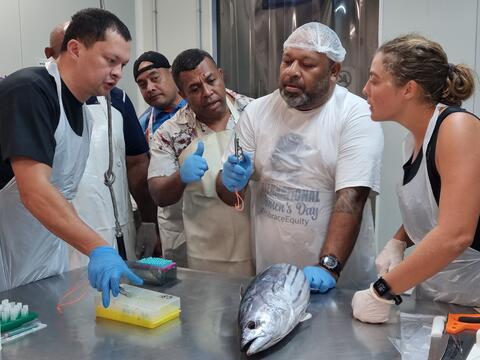Defining the stock structures of commercial Pacific species to improve advice for fisheries management
When we assess the status of a fish stock, we need to consider the biology, movement and potential mixing of this stock. For example, when we assess the skipjack, yellowfin and bigeye tuna stocks, we assume that single stocks exist for each species in the western and central Pacific Ocean (WCPO) and the eastern Pacific Ocean (EPO) regions. We also assume that albacore tuna is present as two separate stocks in the North Pacific Ocean and the South Pacific Ocean. These geographic definitions have served fisheries management purposes for a long time, but we now know that there are biological considerations for each of these four tuna species which are important to an improved understanding of tuna movements and abundance. Building on this knowledge is critical to improving our modelling and thus the scientific advice for fisheries management decisions.

Tuna, billfish, and other fast-moving bycatch species are highly mobile and often cross jurisdictional borders. An accurate picture of how stocks of such species are delineated across the WCPO can help align fishery management units with the ecology of target species, ultimately leading to better management outcomes. We have some recognition of how Pacific tuna stocks - skipjack (Katsuwonus pelamis), yellowfin (Thunnus albacares), bigeye (T. obesus) and albacore (T. alalunga) - move in space and time (spatial and temporal structuring). However, substantial uncertainty still surrounds movement and mixing rates among populations – a situation that currently limits the spatial resolution of the assessment models used to evaluate stock status.
As a move towards a better understanding of tuna stock structure in the region, our oceanic fisheries scientists have worked with many international partners and organisations to review current knowledge, to define and discuss key uncertainties, and to develop a research agenda to reduce these uncertainties. Together, we have identified the continued development and application of new genetic techniques as a key priority, and highlighted the importance of a multidisciplinary approach to addressing open questions on stock structure for these four tunas. FAME’s work in this area reflects the strong regional motivation to advance this research field.
FAME’s oceanic fisheries programme (OFP), in collaboration with university partners and research agencies in the Western and Central Pacific Fisheries Commission (WCPFC) member states, is pursuing several lines of enquiry in this area. Taking a multi-pronged approach through the integration of genetics and genomics, otolith chemistry and shape analysis, muscle stable isotope measurements and modelling of fishery data sourced from across the WCPO, we hope to shed new light on how tuna and billfish populations are ‘connected’ across the region. Ultimately, improved estimates of connectivity will help the stock assessment and modelling (SAM) team within OFP to build more realistic assessment models that incorporate the biology, ecology, mixing and movement of harvested species, as well as the fisheries that target them.
